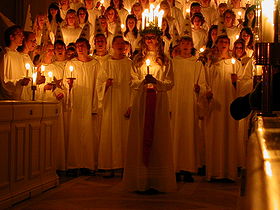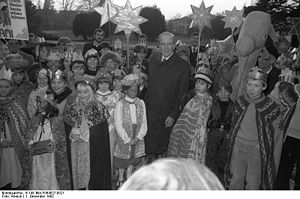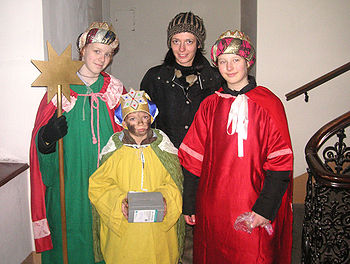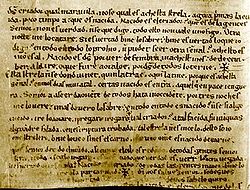
Star Boys' Singing Procession
Encyclopedia

The liturgical drama developed from the 16th Century on, as it was performed by cathedral schoolboys, to become a more secular mystery drama, containing also some ordinary Christmas songs and carols.
The singing procession and play was usually observed each year during the period between 27. December and 6. January (the feast of the Epiphany).
History
After the reformation in the 16th Century, pupils of the cathedral schools in Protestant nations conducted these processions to raise funds to replace the church support that had disappeared. The traditional practice developed differently in the north and the south of Europe.Since then the Star boys' singing procession was common in whole Europe (both on catholic and Protestant side) and in Russia. The custom has also been spread, especially with American immigrants from Italy and Spain, to the New World.
The importance of the Twelfth Day and the feat of the Epiphany grew with the introduction of the Gregorian calendar as the day, after the earlier Julian calendar, also is the Old Christmas Day. The custom passed further on to the general populace as a kind of narrative folk drama, but seems to have declined in its original form since the late 19th century.
Epiphany Singing
The Star boys are walking about from house to house "singing at the doors, with a star on a pole". The dramatic part is introduced by one of the Wise Men knocking on someones door asking: "May the star come in?" If the offer is accepted, they are all invited inside. Then the whole procession will enter the home singing a spcial Christmas carol. Then the play begins.Under the performance the Three Wise Men
Biblical Magi
The Magi Greek: μάγοι, magoi), also referred to as the Wise Men, Kings, Astrologers, or Kings from the East, were a group of distinguished foreigners who were said to have visited Jesus after his birth, bearing gifts of gold, frankincense and myrrh...
, Gaspar
Gaspar
Gaspar is a given and/or surname of Italian, Portuguese, and Spanish, and also Philippines origin that could refer to:-Names:*Roberto Luís Gaspar de Deus Severo, Portuguese footballer commonly known as Beto*Álvaro Gaspar, former Portuguese footballer...
, Melchior
Melchior
Melchior is the name given in later legend to one of the Magi appearing in the Gospel of Matthew. It may also refer to:-First name:* Melchior Anderegg , Swiss mountain guide.* Melchior Berri , Swiss architect.* Melchior Broederlam Melchior is the name given in later legend to one of the Magi...
and Balthazar
Balthazar
Balthazar may refer to:- Traditional and religious uses :* A name commonly attributed to one of the Biblical Magi * An alternate form of the Babylonian king Belshazzar, mentioned in the Book of Daniel...
, are first confronted with Joseph
Saint Joseph
Saint Joseph is a figure in the Gospels, the husband of the Virgin Mary and the earthly father of Jesus Christ ....
, who tries to protect the newborn baby Jesus
Jesus
Jesus of Nazareth , commonly referred to as Jesus Christ or simply as Jesus or Christ, is the central figure of Christianity...
(a doll) and his wife Maria
Maria
Maria is a female given name in many diverse cultures, including Mexican, African, Arab, Armenian, Bulgarian, Catalan, Croatian, English, Finnish, German, Greek, Italian, Maltese, Norwegian, Polish, Portuguese, Russian, Romanian, Pakistani, Afghan, Serbian, Swedish, Spanish.In Roman Empire the...
against the intruders with a wooden axe. The three magi are however most welcome inside after telling that they have brought with them presents to the child. The Wise Men also have to mislead King Herod
Herod the Great
Herod , also known as Herod the Great , was a Roman client king of Judea. His epithet of "the Great" is widely disputed as he is described as "a madman who murdered his own family and a great many rabbis." He is also known for his colossal building projects in Jerusalem and elsewhere, including his...
, who is also trying to find the new born 'prince' in the stable. Both Gaspar
Gaspar
Gaspar is a given and/or surname of Italian, Portuguese, and Spanish, and also Philippines origin that could refer to:-Names:*Roberto Luís Gaspar de Deus Severo, Portuguese footballer commonly known as Beto*Álvaro Gaspar, former Portuguese footballer...
and Melchior
Melchior
Melchior is the name given in later legend to one of the Magi appearing in the Gospel of Matthew. It may also refer to:-First name:* Melchior Anderegg , Swiss mountain guide.* Melchior Berri , Swiss architect.* Melchior Broederlam Melchior is the name given in later legend to one of the Magi...
are fighting the king and his men with swords, together with Joseph using his broad axe, while Mother Mary is nursing her son and Balthazar
Balthazar
Balthazar may refer to:- Traditional and religious uses :* A name commonly attributed to one of the Biblical Magi * An alternate form of the Babylonian king Belshazzar, mentioned in the Book of Daniel...
is taking care of the shining star.
After the performance Judas
Judas Iscariot
Judas Iscariot was, according to the New Testament, one of the twelve disciples of Jesus. He is best known for his betrayal of Jesus to the hands of the chief priests for 30 pieces of silver.-Etymology:...
with the purse are present just to collect money or other kind of gifts from the audience in a large bag. The young boys were usually even treated with strong drinks and cakes afterwards. Then the Star boys are leaving the house for their next visit somewhere in the neighbourhood, singing a song containing a farewell and many thanks for the received gifts.
Costume
The teams of Star boys, aged about ten to fifteen years, are dressed in long white shirts and pointed brown or white paper hats to illustrate the well-known picture of the BabylonBabylon
Babylon was an Akkadian city-state of ancient Mesopotamia, the remains of which are found in present-day Al Hillah, Babil Province, Iraq, about 85 kilometers south of Baghdad...
ean magi. Balthazar
Balthazar
Balthazar may refer to:- Traditional and religious uses :* A name commonly attributed to one of the Biblical Magi * An alternate form of the Babylonian king Belshazzar, mentioned in the Book of Daniel...
is carrying the star and Gaspar
Gaspar
Gaspar is a given and/or surname of Italian, Portuguese, and Spanish, and also Philippines origin that could refer to:-Names:*Roberto Luís Gaspar de Deus Severo, Portuguese footballer commonly known as Beto*Álvaro Gaspar, former Portuguese footballer...
and Melchior
Melchior
Melchior is the name given in later legend to one of the Magi appearing in the Gospel of Matthew. It may also refer to:-First name:* Melchior Anderegg , Swiss mountain guide.* Melchior Berri , Swiss architect.* Melchior Broederlam Melchior is the name given in later legend to one of the Magi...
are armed with wooden swords. The other characters do usually not disguise themselves, but wear also in long shirts, often in brown, green or grey colours and conical hats. Joseph has got a cylindrical paper hat and a wooden timber or broad axe, and King Herod a crowns and him and his soldiers wooden swords. Among the crowd may also be shepherds with long shirts and sticks and some angels with white shirts and wings.
Star on a pole
The star itself was made new each year using tranparent paper on a constructed frame built of wooden lists, and with one to three candles placed inside. The star on the rod had to be movable and turned around all the time, so that the paper should not be heatened and go up in fire.England and Scotland
At a synod in KonstanzKonstanz
Konstanz is a university city with approximately 80,000 inhabitants located at the western end of Lake Constance in the south-west corner of Germany, bordering Switzerland. The city houses the University of Konstanz.-Location:...
in Switzerland
Switzerland
Switzerland name of one of the Swiss cantons. ; ; ; or ), in its full name the Swiss Confederation , is a federal republic consisting of 26 cantons, with Bern as the seat of the federal authorities. The country is situated in Western Europe,Or Central Europe depending on the definition....
at Christmas in 1417 the British clergies performed the Star boy drama for the rest of the participants at the meeting. They wore expensive costumes and had a large shining star. The performance was a huge success at the church conference and could have been one of the main reasons for growing popularity of the drama in post-medieval Europe.
The Star boys' singing procession in England seems later to have been mixed together with several other kinds of carol singers at Christmas. They do not go from house to house, but visit two or three local pubs to receive free beer. Nowadays they are not carrying the shining star anymore, but just a quadrangular paraffin wax on a long stick or even a candle lamp with an ordinary handle. Whereas religious folk plays are the norm in the rest of Europe, the British folk drama is absolutely secular, even if they are mostly taking place on the Christian festival days.
The vigil of the Epiphany is also the time for appointing the Bean-King, i.e. the one who finds the bean in the Twelfth Night cake. (See the French custom about hiding a bean in the The King's Tart before the cake is cut up and eaten.) It has been suggested that the Bean King could be a reminicens of the ancient Roman festival of Saturn
Saturnalia
Saturnalia is an Ancient Roman festival/ celebration held in honour of Saturn , the youngest of the Titans, father of the major gods of the Greeks and Romans, and son of Uranus and Gaia...
, but the connections stated by for instance in The Wordsworth Dictionary of Phrase & Fable, that the Bean-King "celebrations and festivities seemingly derive from the Saturnalia of old Roman times which was held at the same season" is doubtful.
French l'Epiphanie
In France, on the first Sunday in January, they celebrate "Le Jour Des Rois" (The Day Of The Kings) gathering family and friends in someone's home for a big meal which can last for hours. The main reason to arrange the party is however the special dessert cake, called "La Galette des Rois" (The King's Tart). La Galette is a flat, golden-brown cake, about the size of a large pizza, which is made of a brioche dough. Hidden inside, there is small ceramic figure about 1 inch tall that needs to be found by a guest. After asking the youngest child to creep under the table to mention aloud the name of each person to be served, the hostess cuts the cake and serves the guest. The person who finds the ceramic figurine becomes the Bean-King or Queen (Rey de Habas), and has to wear a golden paper crown."Le Jour Des Rois" is also followed by leisurely activities and games for the children. Soon after the crowning, the grown ups get a glass of champagne and the children some soda or limonade. Then the King or Queen has to make a speech giving the official invitation to come to his or her "Palace" for the next year's celebration.
"Stjernespill" in Scandinavia and Finland


Nobel Prize
The Nobel Prizes are annual international awards bestowed by Scandinavian committees in recognition of cultural and scientific advances. The will of the Swedish chemist Alfred Nobel, the inventor of dynamite, established the prizes in 1895...
winners staying in Stockholm are usually woken by Lucia processions on the 13th, and some have unfortunately mistaken the procession for the Ku Klux Klan
Ku Klux Klan
Ku Klux Klan, often abbreviated KKK and informally known as the Klan, is the name of three distinct past and present far-right organizations in the United States, which have advocated extremist reactionary currents such as white supremacy, white nationalism, and anti-immigration, historically...
. Recently school teachers, nursery nurses and Christian principals have during the last decades tried to revitalize the play for small children, to invite their parents to come to the schools, the kindergartens or the churches to see it performed. But the popular and more humorous folkloristic elements are often left behind.
In Finland, a version of the Star boys' procession originating in the city of Oulu
Oulu
Oulu is a city and municipality of inhabitants in the region of Northern Ostrobothnia, in Finland. It is the most populous city in Northern Finland and the sixth most populous city in the country. It is one of the northernmost larger cities in the world....
, a musical play known as Tiernapojat, has become established as a cherished Christmas tradition nationwide. The Tiernapojat show is a staple of Christmas festivities in schools, kindergartens, and elsewhere, and it is broadcast every Christmas on the radio and television. The Finnish version contains non-biblical elements such as king Herod vanquishing the "king of the Moors", and a short song of praise to tsar Alexander
Alexander II of Russia
Alexander II , also known as Alexander the Liberator was the Emperor of the Russian Empire from 3 March 1855 until his assassination in 1881...
.
Central Europe


Caritas (charity)
Caritas Internationalis is a confederate of 164 Roman Catholic relief, development and social service organisations operating in over 200 countries and territories worldwide....
charity projects - unusually in aid of poor children in Eastern European and developing countries.
In France and Belgium, the holiday is celebrated with a special tradition: within the family, a cake is baked which contains one single bean. Whoever gets the bean is "crowned" king for the remainder of the holiday.

Central Europe
Central Europe or alternatively Middle Europe is a region of the European continent lying between the variously defined areas of Eastern and Western Europe...
involves writing the initials of the three kings' names above the main door of the home to confer blessings on the occupants for the New Year. For intances if the year is 2009, it would together with the initials CMB be "20 + C + M + B + 09". The initials was in earlier folkloristic literature interpreted as the names of the Three Wise Men, but is probably a Latin phrase; "Christus mansionem benedicat" (= May Christ bless this house). In Catholic parts of Germany and in Austria, this is done by the Star boys, called Sternsinger (literally "Star singers"). After having sung their songs, recited their poems, and collected donations at a front door they will chalk the initials on the top of the door frame.
In Kashubia
Kashubia
Kashubia or Cassubia - is a language area in the historic Eastern Pomerania region of northwestern Poland. Located west of Gdańsk and the mouth of the Vistula river, it is inhabited by members of the Kashubian ethnic group....
the Star boys' singing is a custom - Trzej królowie.
South of Europe

Orient
The Orient means "the East." It is a traditional designation for anything that belongs to the Eastern world or the Far East, in relation to Europe. In English it is a metonym that means various parts of Asia.- Derivation :...
on their camel
Camel
A camel is an even-toed ungulate within the genus Camelus, bearing distinctive fatty deposits known as humps on its back. There are two species of camels: the dromedary or Arabian camel has a single hump, and the bactrian has two humps. Dromedaries are native to the dry desert areas of West Asia,...
s to visit the houses of all the children; much like Santa Claus
Santa Claus
Santa Claus is a folklore figure in various cultures who distributes gifts to children, normally on Christmas Eve. Each name is a variation of Saint Nicholas, but refers to Santa Claus...
with his reindeer, they visit everyone in one night. In some areas, children prepare a drink for each of the Magi, it is also traditional to prepare food and drink for the camels, because this is the only night of the year when they eat. In Spain
Spain
Spain , officially the Kingdom of Spain languages]] under the European Charter for Regional or Minority Languages. In each of these, Spain's official name is as follows:;;;;;;), is a country and member state of the European Union located in southwestern Europe on the Iberian Peninsula...
, each one of the Magi is supposed to represent one different continent, Europe (Caspar), Asia (Melchior) and Africa (Balthasar). Today the largest Spanish cities organize cabalgatas
Cavalcade of Magi
The Cavalcade of Magi is a typical parade of coaches practically in all the Spanish cities and also some cities and towns in Mexico. The Magi ride through the streets, as their page boys throw candies to children.It is celebrated every January 5 in the evening...
in the evening, in which the kings and their servants parade and throw sweets to the children (and parents) in attendance. The cavalcade of the three kings in Alcoi claims to be the oldest in the world; the participants who portray the kings and pages walk through the crowd, giving presents to the children directly.

Spain
Spain , officially the Kingdom of Spain languages]] under the European Charter for Regional or Minority Languages. In each of these, Spain's official name is as follows:;;;;;;), is a country and member state of the European Union located in southwestern Europe on the Iberian Peninsula...
, but with one small variant; the cake, in this case actually a ring-shaped pastry or Roscón de Reyes, is most commonly bought, not baked, and it contains a small figurine
Figurine
A figurine is a statuette that represents a human, deity or animal. Figurines may be realistic or iconic, depending on the skill and intention of the creator. The earliest were made of stone or clay...
of a Baby Jesus and a dry broad bean. The one who gets the figurine is crowned, but whoever gets the bean has to pay the value of the cake to the person that originally bought it.
Latin America and the North
In Mexico they have the same ring-shaped cake Rosca de Reyes as in Spain. It contains figurines of the Baby Jesus. Whoever gets a figurine is supposed to buy tamales for the Candelaria feast on February the second.In New Orleans, Louisiana and surrounding regions, a similar ring-shaped cake known as a "king cake" traditionally becomes available in bakeries from the Epiphany through Mardi Gras. The Baby Jesus is represented by a small, plastic doll in the cake. The different varieties of pastry involved is large. However, due to recent encroachment of commercialism and liability concerns, king cakes may be available year round and the plastic doll is not hidden in the cake, but just included in the packaging.
External links
- Website to children's charity work on Star singers in Germany.
- The Roman-Chatolic Church in Germany: Star song.
- The Three Wise Men in the Catolic Youth Organization in Austria.
- Historic, Finnish sourches from North Österbotten (Pohjois-Pohjanmaan) Museum.
- Liisa Berg: Tiernapojat – in words og music.
- Taru Kolehmainen: Julesanger (Joululaulujen) – the expression of tradition.
- Preparation to the star play in Oulun.
See also
- Cavalcade of MagiCavalcade of MagiThe Cavalcade of Magi is a typical parade of coaches practically in all the Spanish cities and also some cities and towns in Mexico. The Magi ride through the streets, as their page boys throw candies to children.It is celebrated every January 5 in the evening...
- Liturgical dramaLiturgical dramaLiturgical drama or religious drama, in its various Christian contexts, originates from the mass itself, and usually presents a relatively complex ritual that includes theatrical elements...
- Medieval theatreMedieval theatreMedieval theatre refers to the theatre of Europe between the fall of the Western Roman Empire in the 5th century A.D. and the beginning of the Renaissance in approximately the 15th century A.D...
- Mystery PlayMystery playMystery plays and miracle plays are among the earliest formally developed plays in medieval Europe. Medieval mystery plays focused on the representation of Bible stories in churches as tableaux with accompanying antiphonal song...

